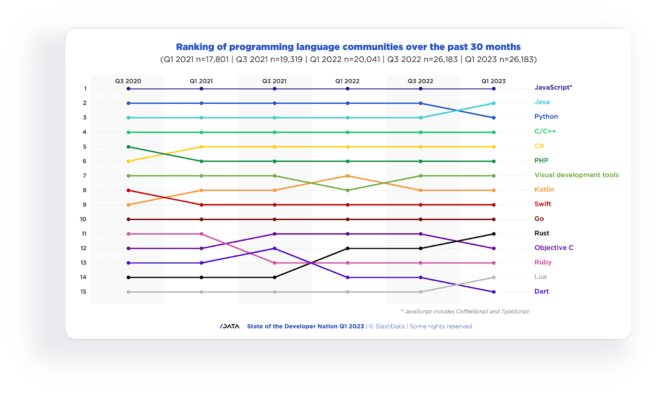The choice of programming language can greatly influence the roles, projects, and general opportunities that a developer has. Languages are a classic subject of debate and represent the foundation of some of the strongest developer communities. Tracking language use is not just for developers however; languages and their communities matter to toolmakers too, as they want to ensure they provide the most useful SDKs.
It can be challenging to accurately assess how widely a programming language is used. The indices available from sources like Tiobe, Redmonk, GitHub’s Octoverse report, and Stack Overflow’s annual developer survey are great, but offer mostly relative comparisons between languages, providing no sense of the absolute size of each community.
The estimates here look at software developers using each programming language; across the globe and across all kinds of programmers. They are based on two pieces of data. First, is SlashData’s independent estimate of the global number of software developers, which was published for the first time in 2017. SlashData estimates that, as of Q3 2023, there are 38.9 million active software developers in the world. Second, is the Developer Nation large-scale, low-bias surveys, which reach tens of thousands of developers every six months. In these surveys, SlashData has consistently asked developers about their use of programming languages across 13 areas of development. This gives a rich and reliable source of information about who uses each language and in which context.
Over the past six months, SlashData’s methodology has specifically been redesigned for estimating the overall usage of each programming language across all areas of development. This was done so, in order to correct for imbalances introduced by development areas contributing more or less than they should to the overall usage of each language. In this chapter, we have retroactively applied our more robust methodology to our historical data as well. Hence, here you are presented with updated language community estimates from the last two years using improved estimation methods.

“JavaScript widens its community size lead”
JavaScript continues to take the top spot for programming languages for the sixth year, with roughly 22.5M active developers worldwide. The language’s dominance is unlikely to be challenged in the near future, as its continued growth in recent years has led to a lead of 5M or more developers ahead of the next closest languages, Java and Python. An important factor in its projected continued popularity – JavaScript’s large community is not dependent on any one software sector. More than half of developers across all software sectors in any capacity – either as a professional, hobbyist, or student – report using JavaScript. Even in sectors where it is not a popular language, for example, IoT devices, we still observe that one in five developers use it.
“22.5M Developers worldwide use Javascript as it continues to be the most popular programming language”
Java and Python remain close to one another in second and third place, with 17.5M and 16.8M developers, respectively. Following a gap of roughly 8M, come C++ and C#; each with around 10.3M and 10.2M developers, respectively, to round out the top five languages. On the opposite end of the spectrum, Lua (1.6M) and Ruby (2.3M) have the fewest users among the language communities we trace. In the latter half of this chapter, we examine select user trends and provide analysis of various community dynamics.
“Dart and Rust grew at an average annual rate of more than 30% in 2023”
JavaScript’s dominance appears as though it will continue as its growth over the past year has outpaced its closest competitors, Java and Python. The 10% annual growth in the number of JavaScript users is noteworthy, considering the communities’ already substantial size. It is, however, below the year-over-year growth of the global developer community as a whole – which, between Q3 2022 and Q3 2023, we estimate to be 16%.
As anticipated, we observe the most dynamism in the smaller language communities. Dart and Rust grew at a rate considerably faster than the overall developer community in the last 12 months. Dart was the fastest-growing language community in 2023. It expanded its community by roughly 33% over the past year. Its popularity is partly due to its association with the Flutter framework, which enables developers to target multiple platforms – mobile, desktop, web, and embedded – with their apps from a single codebase. While Dart is still somewhat of a “niche” community, it is currently estimated that it has just under 3M global users.
Rust, on the other hand, has enjoyed slightly more mainstream acclaim compared to Dart and over the past year has grown by just under a million users to around 3.5M. This growth amounts to a 31% increase from 12 months ago. However, with many large software companies using Rust for its safety features and performance, among other reasons, its continued future growth is all but certain.
Finally, while the annual growth rate of Swift, 21%, is below that of Rust and Dart, the consistency it has shown in attracting new users is one of the factors that make the language community noteworthy. As we approach the 10-year anniversary of the language, its speed and ties to Apple – its creator – suggest that the in-demand language will continue to grow into the future. Swift’s growth, however, is linked to Objective-C’s stagnation as it now serves as the go-to iOS language.
In 2022 and 2023, Objective-C’s community growth has been below that of the growth of the developer community worldwide. Hence, while Apple continues to support the language, with no updates planned from Apple’s side, we do not anticipate a growth in users in the coming years.
Objective-C, however, was by no means the only language community that has not experienced growth in 2023. We estimate that Ruby, Lua, and C all have retained communities that are relatively consistent in size over this past year.
















